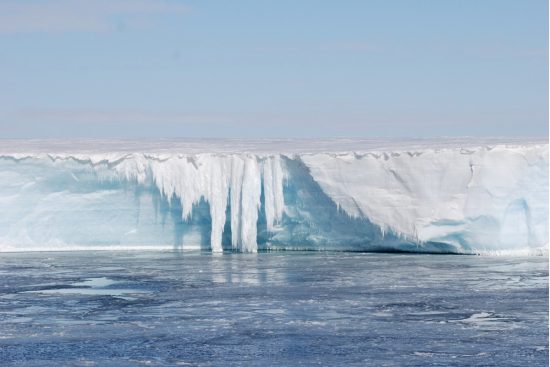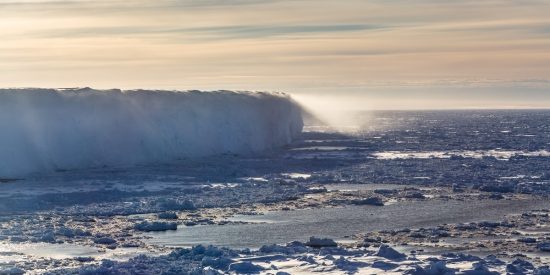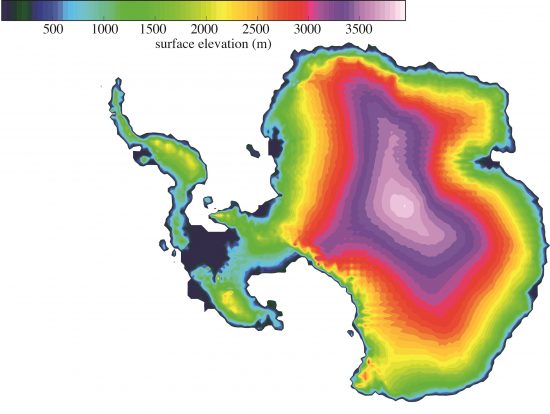




Exceeding critical temperature values can
lead to collapse of the ice sheet and strong rise in sea level
A future warming of the Southern Ocean due
to increased greenhouse gas concentrations in the atmosphere could affect the
stability of the West Antarctic ice sheet. This would cause global sea levels
to increase by several metres.
A collapse of the West Antarctic could
have taken place in the last interglacial period 125,000 years ago, a time when
the polar surface temperature was about two degrees Celsius higher than it is
today. This is the conclusion drawn after a series of model simulations by
scientists of the Alfred Wegener Institute, Helmholtz Centre for Polar and
Marine Research (AWI), now published online in the journal Geophysical
Research Letters.
The Antarctic and Greenland are covered by
ice sheets that store more than two-thirds of the worlds freshwater. As rising
temperatures melt the ice, the global sea level has been rising and threatening
coastal regions. Scientific findings show that Antarctica already contributes
0.4 millimetres to the annual sea level rise. The latest world climate
assessment report (IPCC 2013) makes it clear that the development of ice masses
in the Antarctic is not yet sufficiently understood. Therefore, the climate
modellers of the AWI have analysed changes in the Antarctic ice sheet in the
last interglacial period to come up with these findings for future projections.
"Both, for the last interglacial
period about 125,000 years ago and for the future, our study identifies
critical temperature limits in the Southern Ocean: if the ocean temperature
increases by more than two degrees Celsius compared with today, the
marine-based West Antarctic Ice Sheet will be irreversibly lost. This will then
lead to a significant Antarctic contribution to the sea level rise of some
three to five metres,” said John Sutter, AWI climate scientist
and main author of the study. This increase would take place only if global
warming continues as before.
“Given a 'business-as-usual' scenario of global warming, the collapse of the
West Antarctic could proceed very rapidly and the West Antarctic ice masses
could completely disappear within the next 1,000 years,” said Sutter.
Professor
Gerrit Lohmann, head of the research project, added, “The core objective of the study is to understand the dynamics of the West
Antarctic during the last interglacial period and the associated rise in sea
level. It has been a mystery until now how the estimated sea level rise of a
total of about seven metres came about during the last interglacial period.
Because other studies indicate that Greenland alone could not have done it.”
The new findings provide useful data on
how the ice sheet could behave in the wake of global warming. According to
model calculations, the ice would shrink in two waves. The first would lead to
the retreat of the ice masses that float in the coastal area of Antarctica and
stabilise the major glacier systems of the West Antarctic. With this loss, the
ice masses lying behind the ice sheet and the ice flow into the ocean
increases. As a result, the sea levels would rise and the grounding line
retreat. The rate at which ice flows into the ocean would increase, leading to
rising sea levels and the retreat of glaciers. A stable intermediate state can
be achieved once a mountain ridge under the ice temporarily slows down the
retreat of the ice masses.
If
the ocean temperature continues to rise or if the grounding line of the inland
ice reaches a steeply ascending subsurface, then the glaciers will continue to
retreat even if the initial stable intermediate state has been reached. This
would eventually lead to a complete collapse of the West Antarctic Ice Sheet.
According to Sutter, two maxima could be found in the reconstructions of the
rising sea levels, and the behaviour of the West Antarctic in their newly
developed model could provide the explanation for them.
In
their study, the climate scientists had used two models: a model that includes
various Earth system components like the atmosphere, oceans and vegetation, and
a dynamic ice sheet model that comprises the basic components of an ice sheet
(floating ice shelves, grounded inland ice on the subsurface, the movement of
the grounding line). Two different simulations were used with the climate model
for the last interglacial period to feed the ice sheet model with the necessary
climate information.
Emphasising
the challenges involved in making good estimates, the scientists said that a
reason for the considerable uncertainties when it came to projecting the
development of the sea level, was that the ice sheet did not simply rest on the
continent in steady state but was subject to dramatic changes.
They
continued, “Some feedback processes, such as between the ice shelf areas and
the ocean underneath, have not yet been incorporated into the climate models.
We at the AWI as well as other international groups are working on this full
steam.”
By
improving our understanding of the systematic interaction between climate and
ice sheets, we would be able to answer one of the main questions of current
climate research and for future generations: How steeply – and quickly – can
the sea levels rise in the future?
Link
to study: http://onlinelibrary.wiley.com/doi/10.1002/2016GL067818/full
 Mares
Mares 12th February 2016
12th February 2016